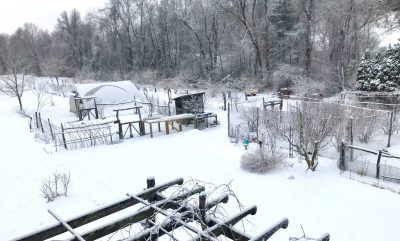Volunteers and Clementine Boxes
/4 Comments/in Vegetables/by Lee ReichCelery Volunteers for Me
I’m always on the lookout for volunteers in my garden, whether they’re people, fungi, plants, or any other organisms. The relationship is usually symbiotic. Human volunteers gain some knowledge and experience; I get some help in my ever-growing farmden. Fungal volunteers work with my plants, drinking in some of the sugars and other goodies plants produce. In return, the fungi protect plants agains certain pests and, in the case of mycorrhizal fungi, fungal threads ramifying through the soil act like extensions of plants’ roots so plants can absorb more nutrients.
But what do plant volunteers get out of our arrangement? Plant volunteers usually arrive in droves so only some can stay. Those that stay get to enjoy especially good growing conditions.
Which brings me to celery.  For the past few years, I’ve allowed celery in the greenhouse to go to seed each fall. The seeds drop and, within a few months, sprout to furnish plenty of seedlings for early summer celery in the greenhouse and later celery out in the garden. All of which is most welcome because celery seedlings are very slow to germinate and grow. Before celery volunteered around here, I had to sow seeds in early February in seed flats, keep the flats warm and moist until the seeds sprouted, transplant the sprouts into individual cells in another flat, and finally transplant the seedlings, after about 10 weeks of care, out into their permanent homes.
For the past few years, I’ve allowed celery in the greenhouse to go to seed each fall. The seeds drop and, within a few months, sprout to furnish plenty of seedlings for early summer celery in the greenhouse and later celery out in the garden. All of which is most welcome because celery seedlings are very slow to germinate and grow. Before celery volunteered around here, I had to sow seeds in early February in seed flats, keep the flats warm and moist until the seeds sprouted, transplant the sprouts into individual cells in another flat, and finally transplant the seedlings, after about 10 weeks of care, out into their permanent homes.
Robust celery seedlings have sprouted and are now growing in a greenhouse bed and in the paths near near that bed, all without any help at all from me. I just lifted clumps of them, separated the seedlings carefully to minimize root disturbance, and “plugged” them back into the ground 8 inches apart. Pest problems are minimized because their new home is a greenhouse bed where celery hasn’t grown for the past two years.
Seedlings from another clump when into individual cells of the APS Propagator; they’ll go outside into the garden in late April. I pulled a few leaves off all these transplanted seedlings so that they don’t lose too much moisture while waiting for their roots to settle into their new homes and get to work.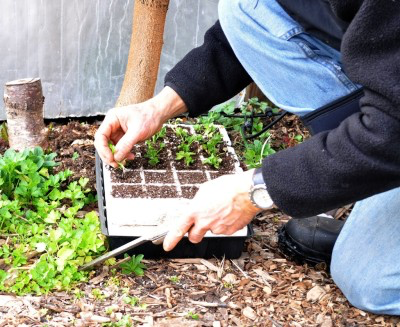
A lot of celery volunteers are still standing there in the paths and old celery bed. They are now weeds.
Ventura is the One for Me
Slow germination and growth, along with the need for a very rich and constantly moist soil, make celery more of a challenge to grow than most other vegetables. Which is one reason that I grow it!
And there’s more. If seedlings are exposed to temperatures that are too cold for too long (55° or less for 10 days or more), the plants bolt, sending up seed stalks instead of growing thick, succulent leaves. Older books also talk about blanching celery, that is, piling soil up around the leaf stalks so they turn pale and tender from lack of sunlight. My celery rarely bolts, and I never blanche it.
One reason for my success with celery (besides, I hope, a greenish thumb) is the variety I grow: Ventura. This variety doesn’t need blanching and is grow thick crisp stalks with rich, but never harsh.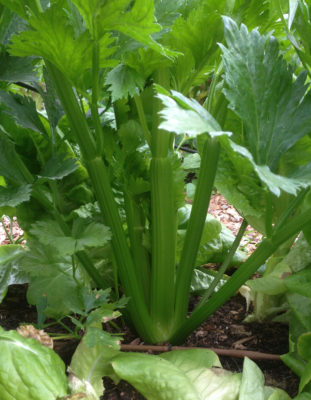
The best celeries I’ve grown were fairly large volunteers that I moved from the greenhouse path into a greenhouse bed one fall. I covered the plants for a few days to increase humidity while the roots were taking hold. All winter, those plants made the juiciest, longest, tastiest celery stalks ever.
Clementines are for More than Just Eating
Clementines are as tasty as the boxes they come in are useful. I can’t bear to throw those boxes out so have a stack of them waiting to be of use.
One box is home to my seed starting supplies: various dibbles and spatulas for lifting small seedlings to replant into larger flats; various sized pieces of plywood for firming soil in seed flats, some with dowels glued to their bottoms to lay out mini-furrows; tape and marking pens for labeling flats; popsicle sticks, also for labeling.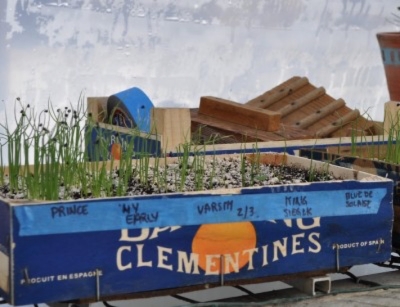
Two other boxes are now being used as seedling flats – for onions and leeks, sown in early February and now well on their way. Each box has 5 mini-furrows in which I sprinkled about 7 fresh onion or leek seeds per inch. The seedlings will grow in those boxes until transplant time, which is a couple of weeks before I’ll be planting out the Ventura celery.
Future Hopes
/4 Comments/in Fruit, Gardening, Planning/by Lee ReichTotipotentiality (Is This a Word?)
I was so excited one day a few years back to receive a box full of leafless sticks by mail. The exciting thing about those sticks was that each one of them could grow into a whole new plant from whose branches would eventually hang luscious apples and grapes.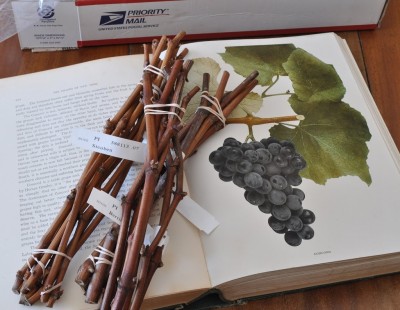
And how did I know the fruits will be luscious? Because a year prior I was at an experimental orchard getting fruit photos for a book I was working on. Of course, I couldn’t help but also taste the fruits, and that’s why Chestnut Crab, Honeygold, Mollie’s Delicious, and King of the Pippins joined the two dozen or so other varieties of apples I already grew. Cayuga White, Bertille Seyve 2758, Steuben, Lakemont, Wapanuka, Himrod, Romulus, and Venus joined my grapes.
It was “totipotence” – of the plants, not me – that allowed me to unlock potential treasures within those mailed sticks. Within a plant, every cell except for reproductive cells has the potential to become a root, a shoot, a flower, a thorn, a fruit, or any other part of a plant. For that matter, the same is true for humans and other animals. All that’s needed are the right conditions to get the various parts to grow – and there’s the rub.
A little art and science puts totipotence to work. In the case of the apples, I grafted those stems onto my existing trees or onto small rootstocks. Existing trees or rootstocks provide nothing more than roots to nourish shoots that will eventually sprout from the sticks. The plant beyond the graft remains genetically that of whatever variety is grafted upon the rootstock. 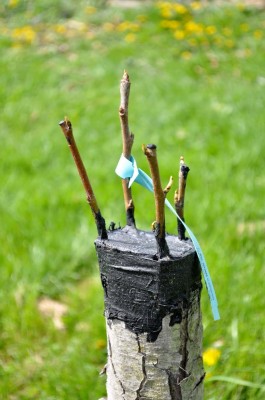 Grape sticks got plunged into the ground where they grew their own roots, shoots, and everything else. Apples aren’t so amenable to growing their own roots.
Grape sticks got plunged into the ground where they grew their own roots, shoots, and everything else. Apples aren’t so amenable to growing their own roots.
I generally wait to graft or set cuttings until early spring. Warmth awakens those sticks. Until then, they’re kept cool and dormant.
I planned on tasting the first fruits of my labors within about 3 years.
Out With the New, In With the Newer
None of those varieties I received as leafless sticks are still with me.
Because of pests, apples are especially problematic to grow here so I subsequently narrowed down my apple holdings to trees of my few very favorite varieties: Macoun, Liberty, Ashmeads Kernel, Pitmaston Pineapple, and Hudson’s Golden Gem.
Except for Wapanuka, the grapes never tasted as good here as they did at that experimental orchard. Is it because of terroir? Was it the setting that influenced my tastebuds? Anyway, they’ve been replaced by other “sticks” — Somerset Seedless, Glenora, and Vanessa — that now bear fruit in the rows with my older, established vines..
Murphy’s Law, Amendments
Although I have gardened for decades, I still consider myself a relative newbie to greenhouse gardening. Sure, I’ve dabbled in various greenhouses over the years but I’ve only experienced the intimate vagaries of my own greenhouse for the last 18 years. It took time for it to finally dawn on me that Murphy’s Law – “Anything that can go wrong, will go wrong” – also applies in the greenhouse. In retrospect, why wouldn’t it?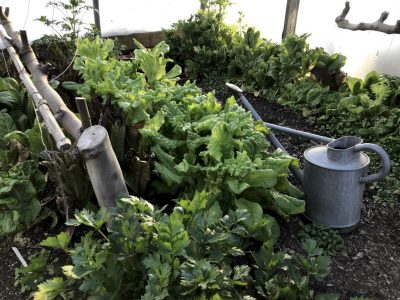
I’ve had my brushes with the law. For instance, one winter evening a few years ago when I went to pick some lettuce for a salad; methinks, “Hmmm, quite nippy in here.” But then, except from when sunlight is beaming through the plastic covering, it’s always nippy in there in winter. Salad greens, kale, chard, and celery thrive in those cool temperatures, which dip into the mid-30s before the propane heater kicks on. (The in-ground figs stay dormant and leafless.)
Still, temperatures felt nippier than normal so I checked the thermometer to confirm and, yes, it was getting down to the high 20s. I then checked the propane heater; it ignored me as I twisted the dial on the thermostat clockwise.
Right then and there, I proposed an amendment to Murphy’s Law: “Anything that can go wrong, will go wrong — at the worst possible time!” Temperatures the night before had plummeted below zero. No wonder a water line had burst that morning. I had assumed that frigid temperatures had made only that corner of the greenhouse too cold. Fortunately, after a lot of nail biting, the gas man and I determined that the pilot light had blown out in the heater. Most plants survived the cold.
One event does not a Law make. Thinking back to another Murphy event, I remember an even more serious freeze in the greenhouse. One day everything looked verdant; the next day mush. (The gas company had forgotten to re-fill the propane tank.) After that event, I rigged up a backup electric heater, just in case temperatures dropped below freezing.
Perhaps yet another Murphy’s Law Amendment is needed. On the night of a more recent freeze, the electric heater was, of course, hooked up. Except it wasn’t poised for warmth. The thermostat was directing it to wake up, but I had forgotten to flip the heater’s “on-off” switch to “on.” My bad.
Live and learn: The sun is now setting, the mercury is now plummeting, but no fear of high winds blowing out the pilot light again. I subsequently upgraded the heater for a pilot light-less one. But when I go out to pick some lettuce, celery, and parsley, I will: Check propane heater, check electric heater, check that the water line is off. And remember to latch the door closed on my way out — really!
Late Winter Sap, Pruning, and Planting
/12 Comments/in Gardening, Pruning, Vegetables/by Lee ReichThe Sap is Flowing
In past years, now is when we would always hope to make enough maple syrup to last until the following year at about this time. Maple syrup consumption has dropped dramatically, leaving me with quite a backlog of the stuff. So trees haven’t been tapped for the past few years.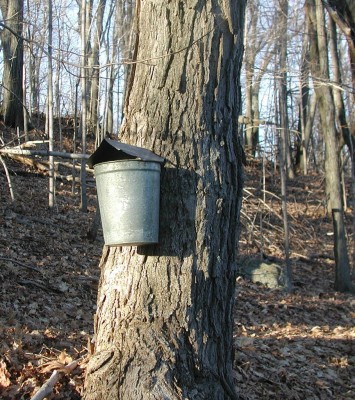
Not that we ever made that much maple syrup. Four tapped trees always produced sufficient sap for a year’s worth of syrup. It had to, because that’s how many spiles (taps) and buckets we own.
Our operation was nothing like what I came upon a couple of weeks ago cross-country skiing in the woods of northern Vermont. All of a sudden tubes had appeared in the pristine, white wilderness. Tubes everywhere! Baby blue plastic tubes, black plastic tubes, interlocking connectors, everything neatly wired into position at chest height and thoughtfully out of the way of any skiers enjoying the woods.
Processing the sap here at home is done quite differently from those commercial operations. Our low-tech approach was to merely add each day’s “catch” from the four buckets to a big stock pot sitting on the woodstove. The woodstove is stoked pretty much continuously this time of year, so the sap was always evaporating, with the added bonus of humidifying the house.
I see a few eyebrows going up. Sticky walls and ceiling are what comes to some minds upon the mention of cooking down maple sap indoors. Well, that’s usually myth. Sticky walls and ceiling only result when the sap is in an active boil and bubbles bursting on the surface of the liquid sent little droplets of sugar water into the air and onto walls and ceilings. But until the final stage of our sap-making, the sap was just slowly evaporating. The vapor given off by slowly evaporating, simmering, or boiling a solution of any sugar and water is nothing more than water vapor. That’s why the maple sugar becomes concentrated in the remaining liquid.
In those final stages of concentration, with much reduced liquid volume, the liquid can indeed reach an active boil. The pot of liquid announces that it’s nearing that stage by starting to gurgle like a baby, at which point it needs to be watched closely, mostly so that the syrup doesn’t get too concentrated or burn. The finish point is when the temperature of the liquid reaches about 219 degrees F.
Another Maple, Not So Good
Someone contacted me to say that, “The squirrels were chewing on Norway maple tree last week and sap was seen dripping down,” then went on to ask if that meant it was too late to prune. Perhaps the squirrels were enjoying some of the sweet sap. Yes, you can tap and boil into syrup the sap of all kinds of maples; I’ve tapped and made syrup from silver maple, red maple, boxelder, and, of course, sugar maple.
Getting back the pruning… It’s not at all too late. It’s fine to “dormant” prune any plants up until the time when they unfurl their leaves in spring.
Another good question might be: Why not just cut the Norway maple down to the ground? The trees are invasive and displacing our sugar maples, they have poor fall color, and they create lugubrious shade beneath which grass and much else can’t grow. Mostly, people keep these trees because they are already in place and full grown.
Pea Planting, Almost
Despite snow covering the ground on the ground, I’m still planning to scratch open a furrow and plant peas – the first outdoor planting of the season – on April 1st.
Given the white blanket, which may not be around by the time you read these words, some people might think me crazed for planting peas so soon. Then again, those people who insist on getting their peas in the ground before St. Patrick’s Day might think I’m dragging my heals.
Here are the facts: Peas grow best at cool temperatures, making early sowing a must. The seeds will sprout whenever the soil temperature is above 40 degrees F. But St. Patrick’s Day can’t be the universally best time to sow peas because different places experience different climates on that date. It’s probably too late in Florida, too early in Maine, and just right in Ireland.
So call me a fool if you like, but I’m still planning on an April Fools Day planting for my peas. I’ll wait a few more days if the ground is frozen or covered with snow. Just a few days though, because things move quickly this time of year.